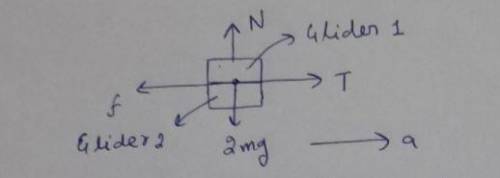
Physics, 12.03.2021 15:20, alyssaflores
In a glider stunt at an air show, a towing airplane (motorized plane pulling the gliders) takes off from a level runway with two gliders in tow. The gliders are pulled by two tow ropes, the first glider attached to the back of the towing plane and the second glider attached to the back of the first glider. The mass of each glider is 700 kg. The total resisting force (air drag plus friction with the runway) on each glider is equal to 3700 N. The resisting force can be assumed to be constant during the take off. The maximum allowed tension in the tow rope between the transport plane and the first glider is 12000 N. The maximum allowed tension in the second tow rope is the same as the first tow rope. If the takeoff speed for the gliders and the plane is 40 m/s, what minimum length of runway is needed for take off? Express your answer in meters.

Answers: 1
Other questions on the subject: Physics

Physics, 22.06.2019 11:40, johanperezpere51
Imagine that you have two balloons (or, better yet, actually inflate two balloons, if possible). create static electricity around one of the balloons by rubbing it against your hair or your sweater and then bring that balloon close to the other balloon, which has not been charged. try this with at least one other object—and for variety in the discussion, avoid using an object already described by your classmates. then, for your initial post to the discussion, answer the following questions: what happened with the two balloons?
Answers: 3

Physics, 22.06.2019 12:30, ayoismeisjjjjuan
Cathy is pedaling down a steep hill on her bicycle and wants to be able to coast up the next hill, which is 25 meters high, without pedaling. cathy and her bicycle have a mass of 75 kg. assuming her bicycle is 100% efficient, what would her speed have to be?
Answers: 3

Physics, 22.06.2019 22:50, cbogrett
Cyclotrons are widely used in nuclear medicine for producing short-lived radioactive isotopes. these cyclotrons typically accelerate h- (the hydride ion, which has one proton and two electrons) to an energy of 5 mev to 20 mev. this ion has a mass very close to that of a proton because the electron mass is negligible—about 1 2000 of the proton’s mass. a typical magnetic field in such cyclotrons is 1.9 t. (a) what is the speed of a 5.0-mev h-? (b) if the h- has energy 5.0 mev and b = 1.9 t, what is the radius of this ion’s circular orbit?
Answers: 1
Do you know the correct answer?
In a glider stunt at an air show, a towing airplane (motorized plane pulling the gliders) takes off...
Questions in other subjects:

History, 09.11.2020 23:00



Mathematics, 09.11.2020 23:00


History, 09.11.2020 23:00

English, 09.11.2020 23:00

English, 09.11.2020 23:00

Mathematics, 09.11.2020 23:00







